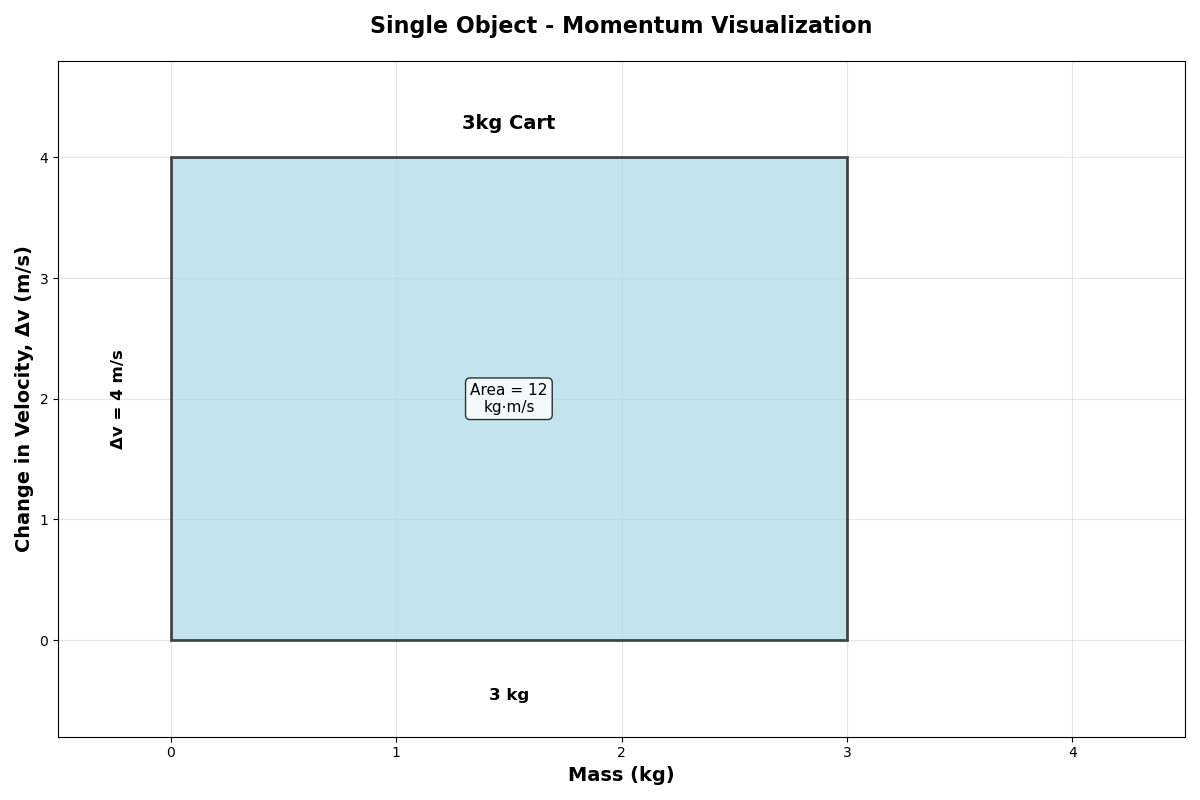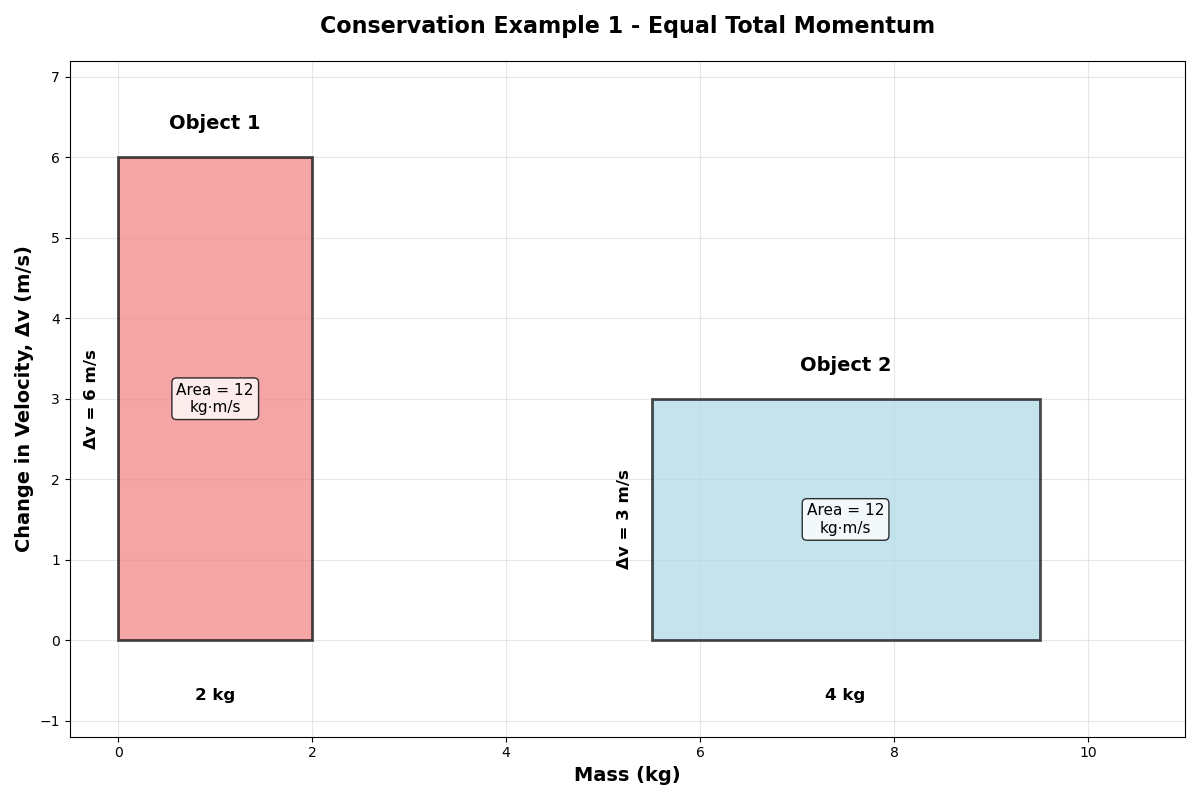P3L5: Mass, Speed, and Force
Is there a similar mathematical relationship between the masses and the changes in velocity for two objects in any other collision conditions?
In our previous investigations, we explored how the masses of two colliding objects relate to their changes in velocity. We found a mathematical relationship that when one object was initially at rest, the ratio of masses equals the negative ratio of velocity changes:
\[\frac{m_A}{m_B} = -\frac{\Delta v_B}{\Delta v_A}\]This relationship helped us make predictions about collisions with specific conditions, but we haven’t tested whether it works in all situations. Today, we’ll investigate if this same relationship applies when both objects are initially moving, or when objects bounce apart instead of sticking together. By testing our model under different conditions, we can determine if we’ve discovered a more general principle that might help explain all collisions.
Part I: Testing Our Mathematical Model
Investigation Question
In our previous lesson, we discovered a mathematical relationship between mass and velocity changes in collisions:
\[\frac{m_A}{m_B} = -\frac{\Delta v_B}{\Delta v_A}\]But does this relationship hold for different collision conditions beyond what we’ve tested?
Checkpoint 1: Make a Prediction
Based on our previous findings, predict whether you think this mathematical relationship will work for:
- Elastic collisions (where objects bounce apart)
- Inelastic collisions (where objects stick together)
- Collisions where both objects are moving initially
Write and/or draw diagramatic notes of the collision types above in your notebook. Write your predictions and reasoning in your notebook.
Testing with Simulation
We’ll use a collision simulation to test our mathematical model systematically under various conditions:
- Different mass ratios
- Different initial velocities
- Both elastic and inelastic collisions
Lab Activity: Complete the P3L5 Collision Simulation Lab to systematically test our mathematical relationship. The lab guide provides step-by-step instructions for:
- Setting up different collision scenarios
- Collecting accurate data using proper experimental design
- Testing the mathematical relationship
- Analyzing your results
Follow the lab guide to conduct your investigation, then return here to learn about the deeper meaning of your discoveries.
Part II: Discovering Conservation
Simplifying Our Equation
When we cross-multiply our ratio equation, something important emerges:
\[\begin{align} \frac{m_A}{m_B} &= -\frac{\Delta v_B}{\Delta v_A} \\ \\ \text{Cross-multiplying:} \\ m_A \times \Delta v_A &= -m_B \times \Delta v_B \\ \\ \text{Rearranging:} \\ m_A \Delta v_A + m_B \Delta v_B &= 0 \end{align}\]This important equation shows us that the sum of mass times velocity change equals zero in any collision.
Checkpoint 2: Understanding Conservation
Look at the equation $m_A \Delta v_A + m_B \Delta v_B = 0$
What does this tell us about the quantity $m \times \Delta v$ in collisions? If the sum equals zero, what must be happening to this quantity for each object?
Discuss with your partner and be ready to share your thinking.
The Conserved Quantity
The equation tells us that the quantity $m \times \Delta v$ appears to be conserved in collisions - what one object loses, the other gains exactly.
This means that in any collision:
- The total amount of $m \times \Delta v$ in the system remains constant
- When one object’s $m \times \Delta v$ increases, the other’s decreases by the same amount
- The overall change in the system is zero
Part III: Visualizing with Geometry
Rectangle Model
We can visualize the conserved quantity using rectangles where:
- Width = mass (kg)
- Height = change in velocity (m/s)
- Area = mass × change in velocity

Example: 2 kg and 4 kg Cart Collision
Let’s examine a collision where:
- Cart A: 2 kg, experiences a velocity change of +6 m/s
- Cart B: 4 kg, experiences a velocity change of -3 m/s
We can verify that momentum is conserved by calculating the change in momentum for each cart:
- Cart A momentum change: $m_A \times \Delta v_A = 2 \text{ kg} \times 6 \text{ m/s} = +12 \text{ kg}\cdot\text{m/s}$
- Cart B momentum change: $m_B \times \Delta v_B = 4 \text{ kg} \times (-3 \text{ m/s}) = -12 \text{ kg}\cdot\text{m/s}$
- Total momentum change: $+12 \text{ kg}\cdot\text{m/s} + (-12 \text{ kg}\cdot\text{m/s}) = 0 \text{ kg}\cdot\text{m/s}$

Rectangle representation for momentum changes:
- First cart (2 kg):
- Width = 2 kg
- Height = Δv = +6 m/s
- Area = $2 \text{ kg} \times 6 \text{ m/s} = +12 \text{ kg}\cdot\text{m/s}$
- Second cart (4 kg):
- Width = 4 kg
- Height = Δv = -3 m/s
- Area = $4 \text{ kg} \times (-3 \text{ m/s}) = -12 \text{ kg}\cdot\text{m/s}$
Notice that the total momentum change is zero: +12 kg⋅m/s + (-12 kg⋅m/s) = 0, confirming conservation of momentum. The increase in momentum of the lighter cart exactly equals the decrease in momentum of the heavier cart.
Checkpoint 3: Geometric Model Practice
Try this problem using the rectangle model:
A 3 kg cart changes velocity by +4 m/s in a collision. If it collides with a 6 kg cart, what must the 6 kg cart’s velocity change be?
Draw rectangles to represent both carts and verify that conservation is satisfied.
Part IV: Understanding Momentum
Key Definitions and Vocabulary
Notes on Momentum and Collisions
Copy the following definitions and concepts into your science notebook for future reference.
Prime Notation Convention:
- In physics, we use the prime symbol (‘) to indicate “after” a collision
- Example: v means velocity before collision, v’ means velocity after collision
- This helps us clearly distinguish between initial and final values
- When you see equations with prime symbols, remember they represent the “after” state
Key Definitions:
- Momentum (p): The quantity of motion an object has
- Formula: $p = mv$ (momentum = mass × velocity)
- Units: kg⋅m/s
- Momentum is a vector quantity (has both magnitude and direction)
- Change in momentum (Δp): How much an object’s momentum changes
- Formula: $\Delta p = m \Delta v$ (mass × change in velocity)
- This is the conserved quantity we discovered
- Conservation: A physical quantity that remains constant in a closed system
Mathematical Symbols:
- Delta (Δ): Symbol representing “change in”
- p: Symbol for momentum
Defining Momentum
The conserved quantity we discovered has a name: momentum
- Momentum = mass × velocity (p = mv)
- Change in momentum = mass × change in velocity (Δp = mΔv)
Conservation of Momentum
Our equation can be rewritten to show momentum conservation:
Before collision: $p_A + p_B = m_A v_A + m_B v_B$
After collision: $p_A’ + p_B’ = m_A v_A’ + m_B v_B’$
Conservation principle: $p_A + p_B = p_A’ + p_B’$
This tells us that the total momentum before a collision equals the total momentum after the collision.
Types of Collisions
Elastic collision: Objects bounce apart after collision
- Examples: billiard balls, bouncing superballs
- Objects separate after impact
- Both momentum and kinetic energy are conserved
- Objects have different final velocities
Inelastic collision: Objects stick together or deform during collision
- Examples: car crashes, putty balls hitting a wall
- Objects may stick together or remain in contact
- Momentum is conserved, but kinetic energy is not
- Perfectly inelastic: Objects stick together completely after collision
Understanding Perfectly Inelastic Collisions
In perfectly inelastic collisions, objects stick together after impact, forming a single combined object moving with the same final velocity.
When Objects Stick Together
When two objects stick together in a collision, we apply momentum conservation with a key insight:
- Before: Two separate objects with their own velocities
- After: One combined object with a single velocity
Mathematical approach:
\[m_1 v_1 + m_2 v_2 = (m_1 + m_2)v_{final}\]Notice that the final mass is the sum of both original masses, since they’re now moving together as one unit.
Worked Example: Perfectly Inelastic Collision
A 1500 kg car traveling at 20 m/s collides with a 1000 kg stationary car. The cars stick together after collision. Find their final velocity.
Given:
- Car 1: $m_1 = 1500$ kg, $v_1 = 20$ m/s
- Car 2: $m_2 = 1000$ kg, $v_2 = 0$ m/s
- After collision: combined mass $(m_1 + m_2) = 2500$ kg
Solution:
\[m_1 v_1 + m_2 v_2 = (m_1 + m_2)v_{final}\] \[(1500)(20) + (1000)(0) = (2500)v_{final}\] \[30,000 kg \cdot m/s + 0 = 2500\,\text kg \cdot v_{final}\] \[v_{final} = 12 \text{ m/s}\]Physical Interpretation:
- The moving car had momentum of 30,000 kg⋅m/s
- After sticking together, this momentum is shared between both cars
- The larger combined mass (2500 kg) results in a slower final velocity (12 m/s)
- Total momentum is conserved: 30,000 kg⋅m/s before = 30,000 kg⋅m/s after
Key Differences Between Collision Types
| Collision Type | Objects After Impact | Final Velocities | Example |
|---|---|---|---|
| Elastic | Separate objects | Different velocities | Billiard balls bouncing |
| Perfectly Inelastic | Combined object | Same velocity | Cars in a crash sticking together |
Checkpoint 4: Inelastic Collision Practice
A 0.5 kg hockey puck moving at 10 m/s collides with a 0.3 kg puck at rest. They stick together after collision.
- What is the momentum before collision?
- What is the combined mass after collision?
- What is their final velocity?
- What is the momentum after collision?
- Verify that momentum is conserved.
Show all calculations in your notebook.
Part V: Applying Momentum Conservation
Real-World Predictions
Using our momentum equations, we can predict outcomes in real collisions, such as:
- Vehicle crashes and safety design
- Sports impacts (football tackles, baseball collisions)
- Spacecraft docking procedures
- Any collision between two objects
Problem-Solving Steps
- Identify the masses and initial velocities of both objects
- Apply conservation of momentum: $p_{before} = p’_{after}$
- Solve for the unknown quantity using algebra
- Check if the answer makes physical sense
Example Problem
A 6000 kg truck traveling at 30 m/s rear-ends a 1000 kg car traveling at 3 m/s.
Given:
- Truck: $m_A = 6000$ kg, $v_A = 30$ m/s
- Car: $m_B = 1000$ kg, $v_B = 3$ m/s
- After collision: truck velocity $v_A’ = 23$ m/s
Find: Car’s final velocity ($v_B’$)
Solution:
\[m_A v_A + m_B v_B = m_A v_A' + m_B v_B'\] \[(6000)(30) + (1000)(3) = (6000)(23) + (1000)v_B'\] \[180,000 + 3,000 = 138,000 + 1000v_B'\] \[183,000 = 138,000 + 1000v_B'\] \[v_B' = 45 \text{ m/s}\]Checkpoint 5: Momentum Conservation Application
Consider a 1500 kg car traveling at 20 m/s that collides with a stationary 1000 kg car.
- Calculate the total momentum before the collision
- If the cars stick together after collision, what would their combined velocity be?
- Verify that momentum is conserved in your answer
Show all work in your notebook.
Looking Ahead
Our discovery of momentum conservation raises new questions:
- How does the force applied during a collision relate to momentum change?
- How does the time duration of the collision affect the outcome?
- Can we predict the forces involved if we know the momentum changes?
These questions will guide our next investigation into the relationship between force, time, and momentum change - leading us to discover the impulse-momentum theorem.
Exit Ticket: Momentum Conservation
Answer these questions on a half sheet of paper and turn it in at the end of class.
- What is momentum and how is it calculated?
- State the law of conservation of momentum in your own words.
- A 2 kg ball moving at 5 m/s collides with a 3 kg ball at rest. If they stick together, what is their final velocity?
- How might understanding momentum conservation help engineers design safer vehicles?
